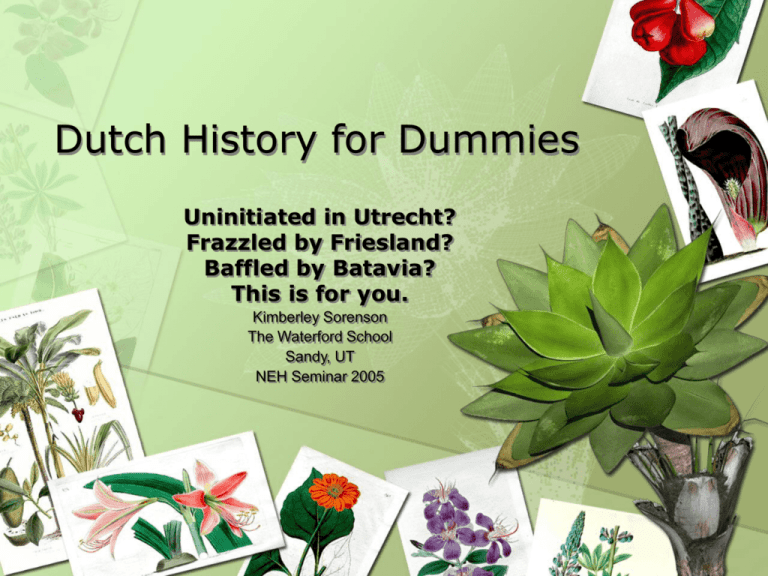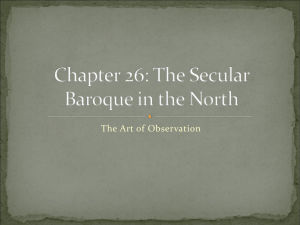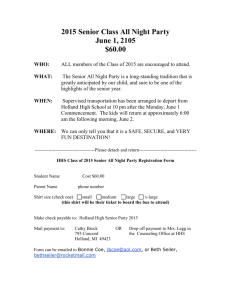PowerPoint Presentation - Dutch History for Dummies
advertisement

Dutch History for Dummies Uninitiated in Utrecht? Frazzled by Friesland? Baffled by Batavia? This is for you. Kimberley Sorenson The Waterford School Sandy, UT NEH Seminar 2005 The Place: North The Place: South 13th Century • Part of Holy Roman Empire, which is a loose confederacy including Germany, Bohemia (the Czech Republic), parts of Austria, Sicily, parts of Northern Italy • South (Flanders and Brabant) is urbanized center of textile processing; linked to Hansa in Baltic, England, and Tuscany. • North is a frontier, being reclaimed by windmills and dikes 14th century • Neither North nor South is badly damaged by Black Death. • North: bulk shipping of timber and grain from Baltic and salt from Portugal and W. France • Many medium cities, which are commercialized but not ports. • South: firmly entrenched in Mediterranean and Tuscan cultural and economic life 15th century • Death of last Count of Holland • North and South united under house of Burgundy • 1430’s: States General and centralized finance • Headquarters in Brussels; south engaged in 100 Years War in France • North left to duke it out with Hansa on their own Revolt of 1477-1492 • Habsburgs bring foreign troops, centralization, and high taxation to Netherlands to help in their wars with France • Nobles revolt • Large businessmen prefer stability of Habsburgs • Revolt fails Modern Devotion • • • • Latin schools and literacy in the north Inner development of the individual Under the radar; did not address dogma Imitation of Christ by Thomas a Kempis, 1473 • Agricola is an adherent; first humanist (literary Latin and Greek) • Inspires Erasmus Erasmus and Northern Renaissance • Humanism has the potential to deepen and purify man’s relationship with Christ • Important to avoid paganism, “Judaism” (ceremony, ritual, and legalism), and schism • Enchiridion (1503) practical modeling on Christ • Armed truce with Luther Habsburg Dynasty • Ferdinand and Isabella unite Spain and complete Reconquista, 1492 • Only institution which unites Spanish districts is Catholic church • Their daughter Juana “la Loca” marries Philip the Fair, son of Maximilian Habsburg and Mary of Burgundy • (Juana’s sister is Catherine of Aragon, Henry VIII’s first wife). Charles V • Son of Juana la Loca and Philip the Fair • Nephew of Catherine of Aragon • Holy Roman Emperor; defending Catholic Europe against Luther (1519) • Cortes (1519) and New World • Hungarians petition for admission to get out of way of Ottoman Turks • “Defending” Rome from French invasion • He’s got a lot on his plate Charles V and Netherlands • Provincial governors are “stadholders.” • Nobles are less involved in cities; gone to war and replaced by bureaucrats • Pragmatic Sanction, 1548: Habsburg Netherlands • Stability, improved traffic and dam management Reformation • Church in retreat after 1480 • Luther 1519 • Charles V imposes Inquisition and book burnings 1521 • Eternal Edict 1550—death sentence • No possibility of public discussion; Protestantism in Netherlands does not harden into clear party line • William the Silent and the politiques Dutch Agriculture and Economy • Free peasants on small lots • East is old tyme, maritime must produce food for cities • By 1500, Agricultural Revolution – Drainage, dams, canals, windmills – Manure from fodder crops and pens – Some switch to dairy after import Baltic grain – Need to provision cities – High rents and small farms 16th century economy, South • “Rich trades” textiles, spices, metals, and sugar at Antwerp on Scheldt River; associated trades of woolen cloth, linen, tapestries, sugar-refining, metal-refining. • Expensive ships for long-distance trade of high-value goods owned by a few wealthy merchants 16th century economy, North • In North: growth of maritime “depot” cities for Baltic grain and timber • Shipping, including shipbuilding, rope, sails, barrels, sacks, etc. By 1580, Holland has 1,800 seagoing ships. (Venice had 300 at height) • Fluit by 1590s; simple (small crew) and roomy • Multiple owners Dutch Grievances, 1549-1566 • Bureaucrats replacing nobles • Drain of wars with France in 1540s • Low countries become Habsburg fortress for the invasion of France • Spanish Philip II succeeds father in 1555, who abdicates after Peace of Augsburg • France slips into Wars of Religion • Dutch exiles import Calvinism and “hedgepreaching” • By 1560s, some toleration of Protestantism in north Intensification • Beeldenstorm, 1566 • Duke of Alva and the Council of Blood, 15671572 • C of B targets non-noble wealthy; many leave • 1569, Alva inaugurates taxes for standing army • Sea-beggars (Protestants) seize ports • William the Silent leads discouraging fight • Dikes cut at Leiden, 1574 and “Almighty intervenes.” Union, 1575 • Union of Holland and Zeeland June 1575 • Nucleus of state; common financial, administrative, military • Religious toleration and University of Leiden • Collapse of Spanish finances, fall of 1575 • “Spanish Fury” at Antwerp by mutineers Spanish resurgence • Alva replaced by Don Juan, who is replaced by the Duke of Parma • Collapse of finances in 1575 leads to mutiny and “Spanish fury” • Nevertheless, Spain reconquers south between 1579-1585 • William the Silent assassinated by a Catholic in the spring of 1581 Spain or Holland? • Elizabeth sends Earl of Leicester, who is rabid Calvinist, to help against the Spanish • Unpopularity of English makes Holland look better • Oldenbarnevelt: dike and secretary guy with the personality of a cuttlefish, but he strengthens Holland and gets things done. • Spanish Armada, 1588. • 1609: 12 Years Truce Dutch Military Power • Brilliant general Maurits, son of William • New engineering (paying soldiers to dig, wooden mats for guns) speeds sieges • More money from trade; by 1597, 2nd largest army in Europe and most advanced; navy coming right along • “Military revolution” & problem of protecting civilians; discipline & feeding • Drill, harbor dredging, and consulting Institutional Framework • 7 provinces and 18 towns • All questions had to be distributed to towns (and discussed) in advance • Each province had one vote in States General (the Generality) • Raad van State, or Council of State, is basic organ of administration • Admiralty colleges for customs, port and river maintenance • Highest office in province was Stadholder, who administered justice Immigration after siege of Antwerp, 1585 • People from South, many of whom brought skills (linen bleaching, tile work, etc) distinct from those in north, hence little friction • People from poorer eastern portion of country • During 30 Years War (1618-48) German immigrants Economic growth after 1590 • Spain gets involved in French Wars of Religion in 1590 and lifts Dutch embargo 1609 • Military victories make rivers safe and institute Flemish embargo • 1590-1609 “rich trades” and trade with Asia, Africa, and Americas; armed VOC 1602 • 1609-1621 truce and increase of European trade; WIC (West Indies Company) 1621 • 1621-1647 resumption of conflict with Spain and economic constriction, esp. in 1620s Welfare System • Urban growth after 1580 • Ambitious and highly regulated by religious affiliation and domicile • For one thing, they needed the labor • Town pride/status • (Well-ordered has happy implications for mentally ill) • On the order of 10% assisted






